A Nostalgic Pedestrian's Guide To New York City Cinema
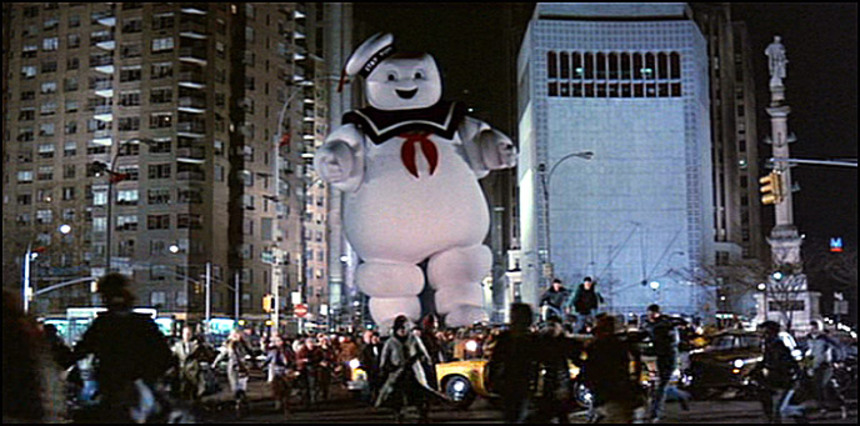
I am doing this T-o-M from a very personal place; it is out of longing... for I miss the city where I started my film writing career. It's the city that exposed me to the looniness that is the New York Asian Film Festival and the downtown glam of Tribeca. Where on a Friday night it was a battle amongst friends on whether to go to a show at Sunshine Cinema or Anthology Film Archives... or BAMcinematek. Every few months when I make the trip up from Maryland for a festival or some such event, I wonder when or if I'll return as a resident.
This T-o-M is from the perspective of someone who ran across the Brooklyn Bridge countless times because, it was in fact, apart of his job. This is coming from someone who slept on park benches; made out on park benches because it was cold and the girl was there. This is coming from someone who rode the subway soaking wet; who took dates to hole-in-the-walls; who played tour guide to European and West Coast friends; who had rats in his apartment, and felt lonely amongst millions of people. The films I present to you here are New York-based films I saw while I lived in that metropolis or ones that I watch to remind me of my time there. These are films that sing, bleed, and are of its people, its architecture, its attitudes, from Brooklyn to the Bronx. This is my unabashed love letter to the Big Apple and its cinema.
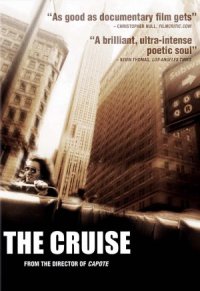 The Cruise -- What a way to start then with the story of a man who fully embodies this city's hopes and dreams, haunts and nightmares. You may have never heard of Timothy "Speed" Levitch before today, or perhaps you saw him in Richard Linklater's Waking Life as the man who on really romantic evenings would go salsa dancing with his confusion. Well three years before that Bennet Miller dedicated a whole film around him. There's Speed the tour bus guide, the performer and philosopher who ladles out a rich and exciting history of the city to the delight of tourists. Then there's Speed off the bus: The weary native, a saint of the streets who has suffered; a man that only New York could have bred. He talks about the cruise --the way to be in life-- and those suffocating forces which are the anti-cruise. Whether on wheels or on foot, Speed is taking that cruise, living every moment in that flow; reevaluating, reimmersing, rebirthing at every opportunity. Which is a challenge for sure. And all the city has to do is keep up.
The Cruise -- What a way to start then with the story of a man who fully embodies this city's hopes and dreams, haunts and nightmares. You may have never heard of Timothy "Speed" Levitch before today, or perhaps you saw him in Richard Linklater's Waking Life as the man who on really romantic evenings would go salsa dancing with his confusion. Well three years before that Bennet Miller dedicated a whole film around him. There's Speed the tour bus guide, the performer and philosopher who ladles out a rich and exciting history of the city to the delight of tourists. Then there's Speed off the bus: The weary native, a saint of the streets who has suffered; a man that only New York could have bred. He talks about the cruise --the way to be in life-- and those suffocating forces which are the anti-cruise. Whether on wheels or on foot, Speed is taking that cruise, living every moment in that flow; reevaluating, reimmersing, rebirthing at every opportunity. Which is a challenge for sure. And all the city has to do is keep up.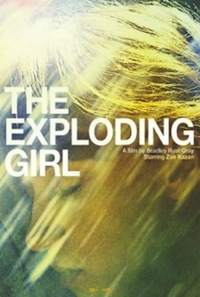 The Exploding Girl -- Bradley Rust Gray's second feature is an urban person's picture to such an extent that it makes no attempt in telling the audience that the location of its story is Brooklyn. And that's the beauty of it. We move through the streets with Zoe Kazan's Ivy, a part of the crowd; anonymous, a pedestrian in the most stifling and everyday sense. These long-lensed tracking shots span from one end of a block to another. As much as they are intimate and personal, the physical distance of the camera adds a feeling of utter, unfriendly detachment. In this way cinematographer Eric Lin and Gray are able to create a denizen's map of the city that goes nowhere and everywhere. It is a mapping of a history, collective and personal, that betrays none of the wonder or dread of the place, grounding itself in a reality that we rarely see in film. Ivy, with her friend Al (Mark Rendall), wander these streets with a purpose, towards a destination more inner than outer. The film then, interestingly enough, offers the big city as a respite over the usually welcome quiet of a rural college town.
The Exploding Girl -- Bradley Rust Gray's second feature is an urban person's picture to such an extent that it makes no attempt in telling the audience that the location of its story is Brooklyn. And that's the beauty of it. We move through the streets with Zoe Kazan's Ivy, a part of the crowd; anonymous, a pedestrian in the most stifling and everyday sense. These long-lensed tracking shots span from one end of a block to another. As much as they are intimate and personal, the physical distance of the camera adds a feeling of utter, unfriendly detachment. In this way cinematographer Eric Lin and Gray are able to create a denizen's map of the city that goes nowhere and everywhere. It is a mapping of a history, collective and personal, that betrays none of the wonder or dread of the place, grounding itself in a reality that we rarely see in film. Ivy, with her friend Al (Mark Rendall), wander these streets with a purpose, towards a destination more inner than outer. The film then, interestingly enough, offers the big city as a respite over the usually welcome quiet of a rural college town. 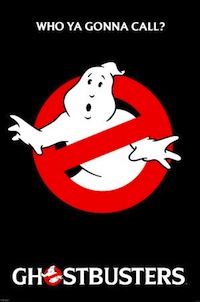 Ghostbusters -- My first cognizant experience with pure movie magic came in the form of Ghostbusters on a beta tape. For most of my life I saw New York through the slime-tinted spectacles of Ivan Reitman's film and when I moved to the city that didn't change much... at least at first. Every time I walked past 55 Central Park West (which was quite often) I couldn't help but think, "I wonder what would happen if I went up to the doorman and said in my best Bill Murray voice 'Hi, I'm going up to Dana Barret's?'" I was bummed to find Lincoln Center's fountain had been remodeled, and then there was the summer Tavern on the Green closed down (though it wasn't because of Gozer). Surprise, surprise, as is so often the case (and yet something we so easily forget) things were in fact changing. It took me a while to get down to Tribeca and visit FDNY Ladder #8 --aka Ghostbusters HQ-- but when I did it felt like I was coming home. This year the fire department faces budget cuts, so the company may have to call it quits, which means an uncertain future for the building. I just have this to say: If Ladder # 8 becomes a parking lot, New York is headed for a disaster of biblical proportions. And I'm not talking fire and brimstone, or dogs and cats living together, but the wrath of the pissed-off film geek.
Ghostbusters -- My first cognizant experience with pure movie magic came in the form of Ghostbusters on a beta tape. For most of my life I saw New York through the slime-tinted spectacles of Ivan Reitman's film and when I moved to the city that didn't change much... at least at first. Every time I walked past 55 Central Park West (which was quite often) I couldn't help but think, "I wonder what would happen if I went up to the doorman and said in my best Bill Murray voice 'Hi, I'm going up to Dana Barret's?'" I was bummed to find Lincoln Center's fountain had been remodeled, and then there was the summer Tavern on the Green closed down (though it wasn't because of Gozer). Surprise, surprise, as is so often the case (and yet something we so easily forget) things were in fact changing. It took me a while to get down to Tribeca and visit FDNY Ladder #8 --aka Ghostbusters HQ-- but when I did it felt like I was coming home. This year the fire department faces budget cuts, so the company may have to call it quits, which means an uncertain future for the building. I just have this to say: If Ladder # 8 becomes a parking lot, New York is headed for a disaster of biblical proportions. And I'm not talking fire and brimstone, or dogs and cats living together, but the wrath of the pissed-off film geek.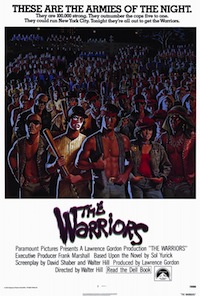 The Warriors -- Can you dig IT? Of course, you can. Okay so I didn't grow up in New York in the seventies, and for all intents and purposes, Walter Hill's film about rival youth gangs across the five Burroughs is actually a fantasy: a comic book/Greek Myth mash-up (though I refuse to acknowledge Hill's "politically correct" version that makes these allusions painfully obvious). Now considering this a fantasy doesn't make the film any less important to the language and pulse of the city. In fact, it intensifies that connection. From it's fiery performances, to it's neon-disco apocalyptic take on street life, to Barry De Vorzon's funky ass-kicking score, The Warriors is New York's pop culture persona squared to perfection. With locations ranging from Riverside Park to the Lower East Side --when it really was quite the hell hole-- the film is a primo travelogue to the legendary city: an ideal asphalt jungle to get lost in, to live in, and to die in.
The Warriors -- Can you dig IT? Of course, you can. Okay so I didn't grow up in New York in the seventies, and for all intents and purposes, Walter Hill's film about rival youth gangs across the five Burroughs is actually a fantasy: a comic book/Greek Myth mash-up (though I refuse to acknowledge Hill's "politically correct" version that makes these allusions painfully obvious). Now considering this a fantasy doesn't make the film any less important to the language and pulse of the city. In fact, it intensifies that connection. From it's fiery performances, to it's neon-disco apocalyptic take on street life, to Barry De Vorzon's funky ass-kicking score, The Warriors is New York's pop culture persona squared to perfection. With locations ranging from Riverside Park to the Lower East Side --when it really was quite the hell hole-- the film is a primo travelogue to the legendary city: an ideal asphalt jungle to get lost in, to live in, and to die in.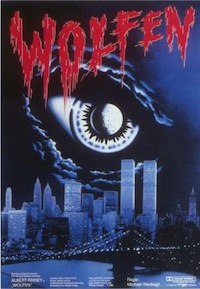 Wolfen -- If human beings are at the top of the evolutionary totem pole for primates, then the Wolfen are top dogs in the canine family. Often mistaken as a werewolf movie (it was released only weeks before John Landis' An American Werewolf in London), this environmental/gentrification themed horror flick makes a great double feature with The Warriors for its genre-bending take on the Big Apple. For a city of millions, director Michael Wadleigh makes New York feel all but empty, shooting in dark corners of alleyways, turning Central Park Zoo into some sort of Post-Gothic menagerie for 'mad scientist' Tom Noonan. The site of the Wolfen's lair, situated in the South Bronx, looks like Dresden circa WWII. At the time of shooting this was a very real location that the production utilized to great effect. Then we have Edward James Olmos traversing the tops of the Brooklyn and Manhattan Bridges, certainly something that one could not get away with in this day and age. And to top things off there is the final showdown on Wall Street, which is perhaps the only time I've seen the area captured on celluloid where its truly claustrophobic size is maintained.
Wolfen -- If human beings are at the top of the evolutionary totem pole for primates, then the Wolfen are top dogs in the canine family. Often mistaken as a werewolf movie (it was released only weeks before John Landis' An American Werewolf in London), this environmental/gentrification themed horror flick makes a great double feature with The Warriors for its genre-bending take on the Big Apple. For a city of millions, director Michael Wadleigh makes New York feel all but empty, shooting in dark corners of alleyways, turning Central Park Zoo into some sort of Post-Gothic menagerie for 'mad scientist' Tom Noonan. The site of the Wolfen's lair, situated in the South Bronx, looks like Dresden circa WWII. At the time of shooting this was a very real location that the production utilized to great effect. Then we have Edward James Olmos traversing the tops of the Brooklyn and Manhattan Bridges, certainly something that one could not get away with in this day and age. And to top things off there is the final showdown on Wall Street, which is perhaps the only time I've seen the area captured on celluloid where its truly claustrophobic size is maintained.And now, briefly, here are five more NYC films that I'm rather fond of: Arthur Barron's sweet teen romance Jeremy, Adrienne Shelly's woman-on-the-edge-of-a-psychotic-break Sudden Manhattan, Josh and Benny Safdie's off-beat The Pleasure Of Being Robbed and Daddy Longlegs, and the ball-busting classic The Taking Of Pelham One Two Three.

Do you feel this content is inappropriate or infringes upon your rights? Click here to report it, or see our DMCA policy.




 (1)-thumb-80x80-93563.jpg)

